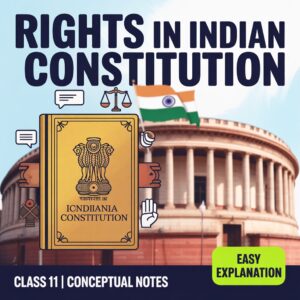
Resources and development
Everything available in our Environment which can be used to satisfy our needs provided , it is technologically accessible , economically feasible and culturally accepted can be termed as ‘ Resource ‘
Interdependent relationship between nature technology & institutions :-
Physical Environment →Human beings ←Technology
↓
Institutions
Classification of Resources
On the basis of Origin
- Biotic-obtained from biosphere & have life e.g-Plants ,
- Abiotic-composed of Non-living things e.g-Air
On the basis of Exhaustibility
Renewable-Can be renewed or reproduced by physical chemical or mechanical process e.g-wind energy
Non Renewable-
- take millions of years in their formation
- Resources like metals are recyclable & some like fossil fuels can’t be recycled & get exhaust with their use e.g-coal
On the basis of Ownership
- Individual Resources -owned privately by individuals e.g-plot, houses , etc
- Community owned Resources -accessible to all members of the community e.g-Burial ground, picnic spot, public parks
- National Resources-Technically all the resources belong to the nation →but for an understanding , resources coming under the territory of country e.g-All the minerals, water resources, forests, wildlife, and oceanic area up to 12 nautical miles (22 km)
- International Resources – not being owned by any specific nation there are international institutions which regular such resources
- e.g- The oceanic resources beyond 200 nautical miles of the exclusive economic zone belong to open ocean & no individual country can utilise these without the concurrence of international institutions
On the basis of status of development
| Potential | Developed | Stock | Reserves | |
| Availability of technology |
√ |
√ |
× |
√ |
| Willingness to use |
√ |
√ |
√ |
× |
| Are we able to use it? |
× |
√ |
× |
Future |
Development of Resources
Indiscriminate use →Problems
- Depletion of resources for satisfying the greed of Individuals
- Accumulation of resources in few hands which in turn divided the society into segments i.e,-haves & have not
- Indiscriminate exploitation of resources has led to global ecological crisis such as global warming ozone layer depletion
- Sustainable development → Rio De Janeiro Earth Summit 1992→Agenda 21
An equitable distribution of resources has become essential for a sustained quality of life & global peace
Sustainable Development
Sustainable economic development means ” development should take place without damaging the environment & development in the present should not compromise with the needs of the future generations
Rio de Janeiro Earth Summit 1992
A summit where more than 100 heads of states met in Rio de Janeiro the Summit was convened for addressing urgent problems of environmental protection and social economic development at the global level .The Rio convention endorsed the global forest principals and adopted Agenda 21
Agenda 21
- Local government should draw its local Agendas global co-operation on common interests mutual needs & shared responsibilities.
- Declaration signed at Rio De Janeiro 1992
- Combat environmental damage poverty & diseases
- Achieving global sustainable development
Resource Planning
why do we need resource planning
- Unequal and uneven distribution of resources
- Balanced resource planning at the national state regional and local levels is required
3 steps of resource planning in India
- Identification & Inventory of resources across the regions of the country
- Surveying mapping & qualitative & quantitative estimation & measurement of the resources
- Evolving a planning structure endowed with appropriate technologies skill & Institutional set up for implementing resource development plans
- Matching the resource development plans with overall national development plans
Availability of Resources → Necessary for the development but merely availability of the resources in the absence of technology & Institutions may hinder development
Countries
- Rich in resources but economically backward
- Poor resources base but economically developed
Conservation of Resources
” There is enough for everybody’s need but no for anybody’s greed →Mahatma Gandhi
Land Resources
Uses
- It supports natural vegetation , wildlife human life economic activities transport and communication system
Limitations
- Land is an asset of finite magnitude
Distribution of Landmass
- Plain area-43%
- Mountains-30%
- Plateau-27%
Land Utilisation
Forest
Land Not available for Cultivation
- Barren & waste food
- Land put to non-agricultural use -Road, buildings etc
Other uncultivated land (Excluding follow land )
- Permanent postures and grazing land
- Land under miscellaneous tree crops groves (not included in net sown area )
- Culturable waste land (left uncultivated for more than 5 agriculture years )
Fallow Land
- current fallow (left without cultivation for one or less than one agriculture year )
- other than current follow (left uncultivated for the past 1 to 5 agricultural years )
Net Sown area →Area sown at least once in a year
Area sown more than once in an agricultural year plus net sown area is known as gross cropped area.
Land use Pattern in India
The use of land is determined both by physical factors such as tomography climate soil types as well as human factors such as population density technological capability and culture & tradition
Total geographical areas →3.28 million sq.km
Land use data however is available only for 93% of the total geographical area
- The land under permanent posture has also decreased
- Most of the other than the current fallow lands are either of poor quality or the cost of cultivation of such land is very high
- The pattern of net sown area varies greatly from one state to another
- it is over 80% of the total area in Punjab & haryana & less than 10% in Arunachal Pradesh Mizoram Manipur & Andaman Nicobar Islands
- Forest Area →33% of geographical area
- For lower than the desired % outlined in the National Forest Policy (1952)
Understand the Significance
- Essential for the maintenance of the ecological balance
- The livelihood of millions of people who live on the fringes of these forests depends upon it
- Waste land includes rocky arid & desert areas & land put to other non-agricultural uses includes settlements roads railways industry etc.
Land Degradation and conservation -Measures
- 95% of our basic needs for food shelter & clothing are obtained from land
- Human activities have not only brought about degradation of land but have also aggravated the pace of natural forces to cause damage to land
Causes
- Deforestation
- Over Irrigation
- Overgrazing
- Minerals processing industries
- Mining & Quarrying
Measures
- Afforestation
- Drip irrigation sprinklers
- management of grazing belts
- Regulating mining
Soil as a Resource
Soil → Most important renewable natural resources
- Medium of plant growth
- supports different types of living organisms
- its is a living system
- Relief parent rock are bed rock climate vegetation & other forms of life & time are important factors in the formation of soil
Types of Soil
- Alluvial Soil
- Black Soil
- Red Soil
- Yellow Soil
- Late rite Soil
- Arid Soil
- Forest soil
Alluvial Soil
- Most widely spread & important soil
- Alluvial soils are very fertile
- Contain adequate proportion of potash phosphoric acid & lime
- Ideal for the growth of sugarcane , paddy wheat and other cereal & pulse crops
- Regions of alluvial soils are intensively cultivated & density populated
Formation and location
- These have been deposited by 3 important Himalayan river system -The Indus, The Ganga, and the Brahmaputra
- Also found in the eastern coastal plains particularly in the deltas of the Mahanadi The Godavari, The Krishna and the Kaveri rivers
- The Alluvial soil consists of various proportions of sand silt & clay
Duars, Chaos & Terai in Piedmont plains
- Apart from the size of their grains or components soils are described on the basis of their age
| Bhangar | Khadar |
| Old Alluvial | New Alluvial |
| Less fertile due to higher concentration of Kanker modules | It is the more fertile than Bhangar & it consist of more fine particles |
Black Soil
- Black in colour also .known as regular soils & cotton soil
Formation & location
- Climate condition along with the parent rock material are the important factors for the formation of black soil
- This soil type is found in Deccan trap (Basalt ) region is made up of lava flows
- They cover the plateaus of Maharashtra savrashtra Malwa Madhya Pradesh and Chhattisgarh & Extend in the south east direction along the Godavari and the Krishna valleys
- Black Soil are made up of extremely fine clay material
- well known for their capacity to hold moisture
- Rich in soil nutrients such as calcium carbonate magnesium potash & lime
- Their soils are generally poor in Phosphoric contents
Similar to Dough
- develop deep cracks during hot weather and sticky when wet
Red and Yellow Soil
Formation & Location
- Red Soil develops on crystalline igneous rocks in areas of how rainfall in the eastern and southern parts of the Deccan plateau
- Also found in the parts of Odhisha Chhattisgarh southern parts of the middle Ganga Plain
- Reddish in Colour → Due to diffusion of Iron in crystalline metamorphic rocks
- It looks yellow when it occurs in Hydrated farm
Laterite Soil
Formation & Location
- The laterite soil develops under tropical & subtropical climate with alternate wet and dry season
- This soil is the result of intense leaching due to heavy rain
- Lateritic soils are mostly deep to very deep acidic , generally deficient in plant nutrients
- Occur mostly in southern states western Ghats region of Maharashtra Odhisha some parts of West Bengal and North- East regions
- Leaching→ washing away of top soil
Characteristics
- Laterite soil is generally poor in humus prone to erosion & degradation
- due to their position on landscape
- After adopting appropriate soil conservation techniques particularly in the hilly areas of Karnataka Kerala & Tamil Nadu this soil is very useful for growing tea & coffee
- Red laterite soil in Tamil Nadu Andhra Pradesh & Kerala are more suitable for crops like cashew nut
Arid Soil
- Sandy in texture & saline in nature
- In small areas the salt content is very high & common salt is obtained by evaporating the H2O
- Arid Soil lacks humus & moisture The lower horizons of the soil are occupied by kankar because of the increasing calcium content downwards
Agriculture
- After proper irrigation these soils became cultivable as has been in the case of western Rajasthan
- Forest Soil → Mountain Soil
- Found in the hilly & mountains areas where sufficient rain forests are available
Characteristics
- Soil texture varies according to the mountain environment where they are formed
- Loamy & silty in valley sides
- Coarse grained in the upper slopes
- In the snow covered areas of Himalayas these soils experience denudation & are acidic with low humus content
- The soils found in the lower parts of the valleys particularly on the river terraces & Alluvial fans are fertile
What is Soil Erosion
- The denudation of soil cover and subsequent washing down is described as soil erosion
Causes of Soils erosion
- Human activities – Deforestation overgrazing construction & mining defective farming method
- Natural forces-Wind glaciers & water leads to soil erosion
- Gullies are being created due to running water
- Bad land known as Ravines in chambal basin
- Sheet erosion- When sheet of top soil is washed away due to water flow
- Wind erosion- when loose soil or soil at slope blows due to wind
Soil conservation Method
Contour Ploughing → Terrace cultivation
Strip Cropping → Shelter belt farming



